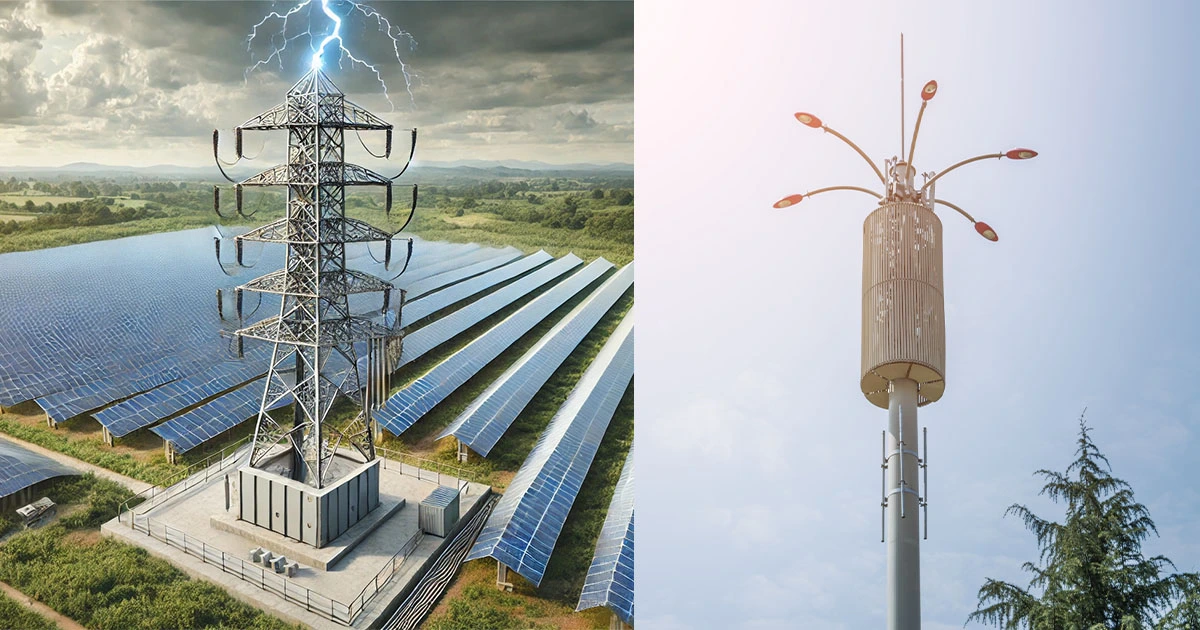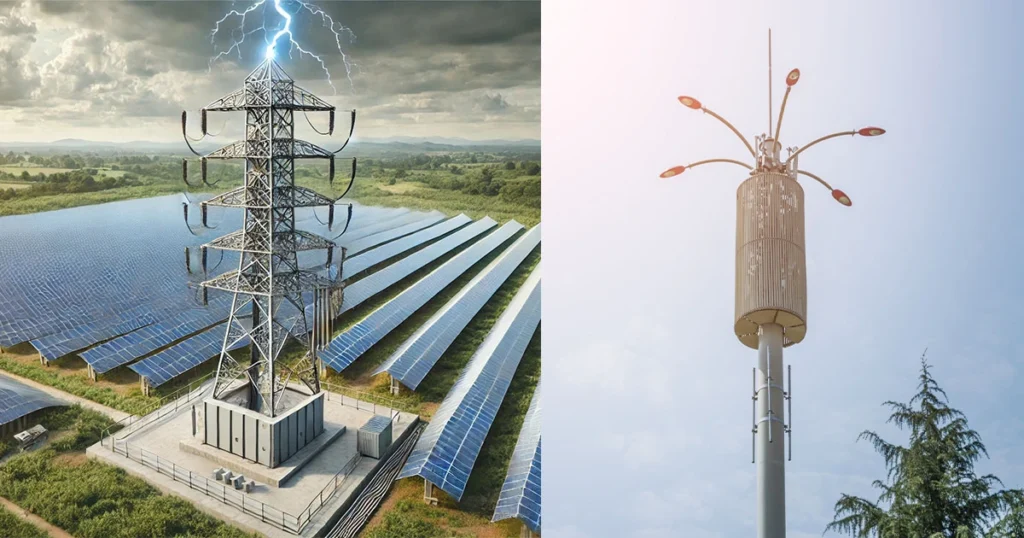Lightning Arresters: Types, Benefits, and Their Role in Solar Power Protection
Lightning arresters protect electrical systems from high-voltage lightning surges. They ensure safety and reliability by channeling excess voltage to the ground. Used in various setups, including solar installations, these devices are critical to preventing damage and ensuring continuous operation.

What is a Lightning Arrester?
A lightning arrester diverts harmful lightning surges away from electrical systems. It prevents voltage spikes from damaging equipment. Installed at strategic points, it safeguards buildings, grids, and renewable energy setups.
Types of Lightning Arresters
Rod Gap Arrester
A simple device with two rods and an air gap. Effective for small installations. Low cost and easy to install but less reliable during repeated surges.
- Expulsion Type Arrester
Uses an arc to expel surges. Mostly used in low-voltage systems. Requires frequent maintenance and may not suit modern grids. - Valve Type Arrester
Uses nonlinear resistors and a spark gap for surge protection. Ideal for medium and high-voltage systems. Durable and highly efficient. - Metal Oxide Arrester (MOA)
Contains zinc oxide blocks for high efficiency. Offers superior protection and longevity. Common in industrial setups and solar installations. - Multi-Chamber Arrester
Advanced design for handling large surges. Suitable for high-voltage transmission systems. Costlier but reliable under extreme conditions.
Applications of Lightning Arresters
- Protect buildings and towers from lightning damage
- Ensure safety of electrical grids and substations
- Safeguard industrial machinery and automation systems
- Critical for solar power systems and wind farms
Why Use Lightning Arresters in Solar Installations?
Solar systems are exposed to outdoor weather. Lightning strikes can damage panels, inverters, and batteries. A lightning arrester safeguards equipment and maintains consistent energy production without interruptions. It also protects connected equipment and wiring from voltage surges.
Advantages of Lightning Arresters
- Effective Protection
Prevents costly damage to electrical systems. Ensures long-term safety of equipment. - Improved System Reliability
Minimizes downtime and operational disruptions. Ensures consistent performance in harsh weather. - Cost Savings
Reduces repair and replacement expenses. Protects sensitive electronic components. - Scalable for All Systems
Works for small residential setups to large industrial grids. Suitable for various voltage ranges. - Easy Maintenance
Most types are simple to inspect and maintain. Long-lasting when properly installed.
Disadvantages of Lightning Arresters
- Initial Installation Cost
Premium lightning arresters often involve a substantial initial investment.
- Limited Protection Scope
Only protects against voltage surges. Cannot prevent physical damage or fire risks. - Maintenance Requirements
Some types need frequent checks and servicing. - Performance Limits
May not handle repeated strikes effectively. Dependent on the quality and type used. - Potential Malfunction
Improper installation can reduce effectiveness. Aging materials may fail over time.
Choosing the Right Lightning Arrester for Solar Systems
- Voltage Rating
Select an arrester matching the voltage of the solar system. - Energy Handling Capacity
Consider the magnitude of surges expected in your location. - Durability
Choose durable, weather-resistant materials to endure harsh outdoor environments.
- Compatibility
Ensure it works seamlessly with other system components. - Cost vs. Value
Balance upfront costs with long-term benefits.
Installing Lightning Arresters in Solar Systems
- Install near the inverter or combiner box for maximum protection.
- Connect to a grounding system for effective surge dissipation.
- Ensure proper distance from panels to avoid electrical interference.
- Test periodically to ensure functionality during storms.
Pros of Using Lightning Arresters in Solar Systems
- Enhanced System Longevity
Prevents voltage stress on critical components. - Safe Operation
Protects people and property during lightning storms. - Reliable Energy Production
Ensures solar panels and inverters work seamlessly. - Reduced Insurance Claims
Minimizes damage-related expenses.
Cons of Using Lightning Arresters in Solar Systems
- High Initial Cost
Quality devices may increase installation expenses. - Complex Installation
Requires expert knowledge for effective setup. - Periodic Maintenance
Needs regular inspections to maintain performance. - No Fireproof Guarantee
Cannot prevent damage if grounding is poor.
Conclusion
Lightning arresters are essential for protecting solar power systems. They ensure safe, uninterrupted energy production. Investing in a high-quality arrester enhances equipment longevity and reliability. Despite minor drawbacks, their benefits outweigh the costs. Proper installation and maintenance are key to maximizing their effectiveness.
